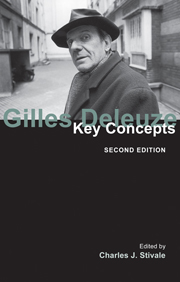3 - Difference, repetition
from PART I - PHILOSOPHIES
Summary
Introduction
Deleuze's notions of difference and repetition are developed within a project that has both a negative and a positive component. The negative or “critical” aspect is the argument that philosophy, in its very conception, has laboured under a “transcendental illusion”, which systematically subordinates the concepts of difference and repetition to that of identity, mostly within what Deleuze calls the “regime of representation”. The illusion is “transcendental” (the term comes from Kant) in so far as it is not simply an historical accident that can be corrected with the right information, but forms a necessary and inevitable part of the operation of thought, and thus requires a perpetual work of critique. Part of Deleuze's project consists in diagnosing this illusion, and showing how it falsifies the “true” movement of thought. In this movement, difference and repetition, in and for themselves, would be appreciated as the ultimate elements and agents of a thought “of the future”: not a historical future, but the future as the essential object of a vital and liberated philosophy, implicit even in philosophies of the past.
The positive component of Deleuze's project can already be glimpsed here, if only by default.
- Type
- Chapter
- Information
- Gilles DeleuzeKey Concepts, pp. 44 - 54Publisher: Acumen PublishingPrint publication year: 2011

